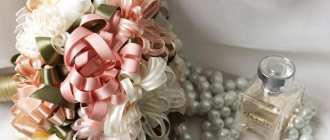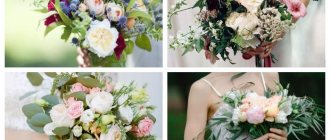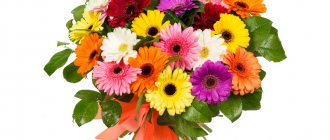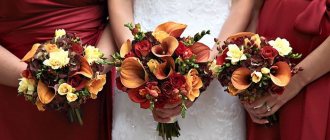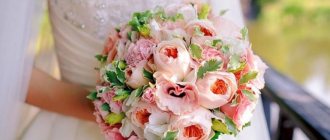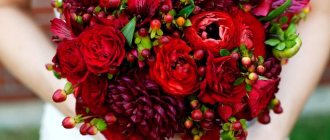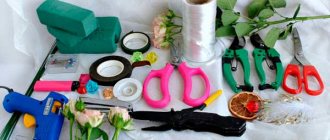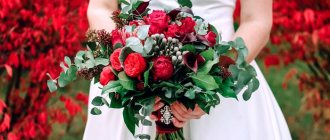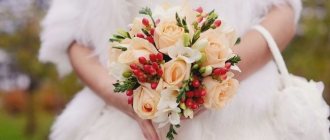One of the important attributes of any wedding is the wedding bouquet. The choice of this accessory should be treated with particular scrupulousness, because a correctly selected wedding attribute can make an unforgettable ceremony, while an unsuccessful flower arrangement can become a real problem. Next, we will look at how to choose a small wedding bouquet for the bride so that it is comfortable and has an elegant appearance.
The benefits of a small bouquet
Content
First of all, when choosing a beautiful bouquet, you should remember that this accessory will stay with the bride all day, until the evening, so you should think about comfort. Bulky, large and lush compositions may look beautiful, but they are unlikely to be suitable for brides, because they will not only be difficult to maintain in their original chic form until the evening, but also simply difficult to wear. In this case, you can choose small, compact bouquets, which have a number of advantages:
- they always look harmonious in the hands of any girl;
- It’s easier to keep a small bouquet fresh and fragrant throughout the day;
- any composition of fresh flowers will be quite heavy, so small options have a clear advantage - they are lighter and more comfortable to wear throughout the day.
Compilation options
Of roses
The most common options for a wedding are bouquets with various roses. This is understandable, because such plants have a lot of advantages:
- come in different shapes, colors and sizes;
- they go well with many colors and are suitable for wedding compositions all year round;
- roses look great with any bridal outfit;
- and also quite resistant to both heat and cool weather, they definitely will not wither or lose their original appearance.
Advice! Small bush roses will also fit perfectly into the bride’s image, you just need to add some other flowers to them.
From gerberas
Bright, colorful and cute gerberas will look great in the hands of the newlywed. They, like the previous version, are resistant to various weather conditions, so they will retain their original appearance throughout the holiday.
From peonies
These flowers have already gained popularity among girls. They look very interesting, gentle and airy. Good in combination with roses and orchids.
It is worth considering the fact that these flowers can be found on store shelves only at the end of the spring season and the beginning of the summer. You also need to know that peonies are very sensitive to heat, especially heat. In such conditions, they will quickly bloom, or they may even fall apart and wither.
From daisies
Although many will say that daisies are very simple and not at all suitable for a holiday, this is not so. After all, they look cute, romantic, and most importantly, natural, which is very popular in recent years.
From orchids
Orchids began to be used not so long ago to make a bridal bouquet, but they have already become a favorite among many representatives of the fairer sex. These plants are varied in shape and color, so finding the ones you like will not be difficult.
From carnations
Another great option for your flower arrangement. Carnations have many benefits:
- their color range is varied, so you can easily find the ones you need for your celebration, accessories and overall image;
- carnations will withstand any weather conditions and remain in a chic form;
- ideally combined with many other inflorescences, such as roses and gerberas.
It is worth remembering that the season for carnations is autumn, so only at this time of year you will find them in large quantities, variety and at the best price.
From calla lilies
Callas are one of the most original and interesting plants. Bouquets of them are incredibly spectacular and unusual. There are plenty of colors, so there will be plenty to choose from. And their main advantage is that they are not afraid of even the coldest weather and will remain in great shape all day long.
From chrysanthemums
Chrysanthemums, at first glance, look simple, but a skilled florist will create a very beautiful and worthy wedding composition from them. They will also harmonize perfectly with roses, gerberas and carnations.
From tulips
As everyone knows, tulips are especially popular in the spring, when they actually grow. These flowers are not yet very popular among brides, as they are very fragile and are unlikely to withstand the entire festive day. But still, some newlyweds prefer tulips, which, by the way, can be combined well with other plants.
From lilies of the valley
Another cute and gentle option, relevant only at the beginning of spring. In another season you will have to try to find them. Lilies of the valley look great either alone or in addition to roses or crocuses.
Who is it suitable for?
When choosing a composition, it is important to pay attention to the shape of the buds; the size of the wedding floral attribute also depends on them: the smaller the buds themselves, the smaller the accessory can be made. It is worth noting that the shape and size of the buds play an important role for each bride. Thus, small dense buds look stylish in the hands of very young brides. Such flowers will emphasize natural tenderness, sophistication and purity. For girls who are at the very dawn of their strength, larger buds, dense or half-open, are suitable, which will emphasize their attractiveness, focus attention on the internal vital energy and add special charm to its owner.
As for mature women, a small wedding bouquet of the bride with loose, open buds, which with their entire appearance will show irresistible feminine energy and emphasize all the brightest features of its owner, is more appropriate.
“Cascade” of red roses on a porta bouquet
The flowing mono composition turns out to be very impressive, thanks to the variety of green textures and the addition of pink waxflower as a filler.
You will need:
- 25 glass-shaped roses;
- 2 sprigs of Italian ruscus, fatsia leaf, boxwood, 1 variegated pitosporum, bunch of lilygrass, fern, 1 – 2 sprigs of salal, asparagus;
- waxflower;
- porta bouquet holder for cascading arrangements;
- satin ribbon.
We lower the bouquet holder with an inclined holder into the water with the sponge down and wait until the material is completely saturated with water, turning from light to rich green. It is advisable to make a solution with recharge for cutting, such as “Crysal”. It will extend the life of the composition. We install the flower bouquet in a tall vase with a narrow neck, filled with any weighting agent: pebbles, sand, liquid. It is important that when assembling a volumetric arrangement with a shifted center of gravity, it does not suddenly tip over. Under no circumstances should you place a floral accessory on the table; delicate rose petals may be damaged. And after a few hours they will begin to darken and dry out.
The bride needs to think in advance about the support for the cascading arrangement during the wedding. You won’t be able to constantly hold such a weight in your hand, but you can’t “plant” fresh flowers anywhere. They must be “in weight”.
We start forming a wedding bouquet in a cascade with greenery. Ruskus sets the shape, outlining both a rounded “cap” and an elongated flowing part. To increase the fullness and density of the center, add a large fatsia leaf, pitosporum and salal.
Using a large variety of greenery will help reduce floristry costs. You will need much fewer flowers, and they are more expensive.
Roll the lilygrass into a ring and insert it into the sponge on one side. Transformed greenery is a fashionable and original element.
We add another tier of salal branches to the composition. The upper leaves should only partially cover the lower ones to create an interesting texture and lightness. You should not achieve complete symmetry of the right and left sides; it is important that visual balance is maintained. Otherwise, the composition will turn out “lifeless”.
The top green tier is made from openwork fern and asparagus. They create a feeling of airiness. We accent the falling part with long blades of lilygrass. We fill possible voids with small boxwood branches, obtaining density and additional volume. To make the greenery shine, you can spray it with a special floral varnish.
For roses, remove the top layer of petals, called the “shirt”. In nature, they protect the bud from the wind, so they have a rough appearance and are often damaged. We shorten the stem, leaving a length of 12 - 15 cm. We make the cut at 45º or more to increase the water absorption surface.
We arrange the flowers in tiers from the bottom to the center, moving in a spiral and forming regular ovals. We make the bottom rose much longer than the others, otherwise the structure of the “cascade” will be disrupted. Closer to the center, cut the flower stems shorter. To create depth, we place a few more low-set buds in the inner part of the composition. Thus, the roses are located at different heights, which creates dynamics and naturalness.
Since there are many flowers and they can destroy the piaflora base, falling out under their own weight, it is better to strengthen the place of their insertion with floral glue. It flows around the stems, firmly fixing it in the sponge.
The filler will be pink waxflower. It will smooth out the contrast of colors and textures, creating a balance between roses and leaves.
We arrange the filler branches loosely so that the greenery is clearly visible. Cascading bouquets of flowers in the final photo:
Choice of colors
Of course, the color of the dress also plays a major role in the variety of shades:
- A mini bouquet should be chosen at the very last moment, when you have already decided on the outfits and main decorations for the wedding - this will help to harmoniously combine it with all the elements at the wedding.
- The floral ensemble should be several tones brighter than the bride's dress itself.
- It should be remembered that blondes with fair skin will suit more delicate shades, while dark-skinned brunettes need to choose brighter and richer colors, but golden tones suit red-haired beauties.
- Modest arrangements will go well with lush and richly decorated dresses; however, you should not choose a very colorful and bright bouquet for a modest dress, in which case it will take a lot of attention. The bouquet should complement the bride's image and look harmonious.
- Choose seasonal flowers - this will not only save on purchasing a bouquet, but will also give you the opportunity to keep it fresh throughout the day, because seasonal flowers are more durable. Calla lilies and peonies look very advantageous in such compositions.
Florist advice
A cascading wedding bouquet goes perfectly with an A-line dress, especially if it has a long train, Greek style styles or straight retro dresses. You should not choose it for a specific “mermaid” cut, with a fitted top and a very wide flounce of the skirt, otherwise you will get a confrontation of shapes.
A princess dress is also not the best “companion” for flowing arrangements. Or there should be very few colors so as not to overload the already rich image.
It would seem that a vertically elongated “cascade” visually slims and adds height to the bride, but due to its splendor, it does exactly the opposite. Flower Waterfall is recommended for tall, slender girls, but not for petite girls or those with luxurious shapes.
Hold the arrangement just below waist level, grasping the “leg” with both hands. The length of the “tail” can be classic - in a ratio of 3:5 or 3:8 to the “hat”. Or unconventional, in proportions 3:11 and even 3:21. In this case, when lowered, at least 15 cm should remain to the floor so as not to impede the bride’s movement.
The most common flowers for the “cascade”:
- orchids;
- roses;
- lilies;
- callas;
- chrysanthemums.
The falling part is:
- greenery of ruscus, eucalyptus, asparagus or ivy;
- jasmine and stephanotis;
- amaranth;
- twigs of Cymbidium orchids;
- clematis.
For filling use:
- Japanese skimmia;
- berries;
- waxflower;
- astrantia;
- gypsophila.
How many flowers should there be in a bouquet
It should be remembered that the composition should not be too colorful. No more than 3 flowers can be combined in one small bouquet.
Also, the wedding floral attribute should harmoniously combine not only the colors themselves, but also the shapes and varieties of flowers. For example, a wild orchid will never look good with daisies, even though they may be in the same color scheme. Choosing a flower, for example, calla lilies, is unlikely to be appropriate in combination with lilies of the valley, and this list can be continued indefinitely.
But a competent combination of various small varieties of flowers in one wedding bouquet can add innocence, romance, attractiveness and even passion to the bride’s image.
Bridal bouquet: popular types and sizes
The 2022 season is full of a wide variety of new products. Naturally, classic bouquets remain trendy. After all, they fit absolutely any wedding look and, when ordering them in a salon, you will never make a mistake with your choice.
Of course, wedding fashion is changeable and every year new ideas for decorating wedding bouquets for the bride appear. Today, bright and unusual shades for wedding fashion are very popular - blue, red (wine), emerald, orange and even lilac.
Pastel shades do not lose their popularity. They always look gentle and touching. Suitable for a wedding ceremony that takes place in summer or spring. Classic medium-sized bouquets of roses or peonies, which symbolize wealth and youth, will look beautiful and harmonious. Bouquets of delicate pink peonies will delight your guests. After all, such flowers are not typical for a wedding bouquet. And everything new and beyond the bounds of conservatism evokes a strong positive reaction. Although in European countries, bouquets of peonies are almost a tradition. These luxurious fluffy flowers have a special energy that will have a positive impact on the family life of the newlyweds.
Bright, large bouquets of different types of flowers without a porta bouquet also look interesting and extravagant. This is a fairly simple type of wedding bouquets, but despite this, they add grace and charm to the image. They look harmonious with long dresses of a straight silhouette. Such bouquets can be tied with beautiful satin ribbons.
A disheveled bridal bouquet without a porta bouquet
Bride's bouquet without a porta bouquet
A new trend this season is small bouquets of one flower. This is an excellent alternative to expensive flower arrangements. The bouquet looks very unusual and even eccentric. In Russia, such bouquets are just beginning to come into fashion, but modern designers and florists predict enormous popularity for them. This is a completely new version of a wedding bouquet, which you can love for its laconic beauty. This bouquet is ideal for a wedding on a modest budget. The right choice of flower and a little imagination will make this 2022 bridal bouquet something special and will amaze guests no less than any other expensive option.
Bride's bouquet of one flower
Decorations for the bouquet
Any composition of living, fresh flowers looks great, but now you can increasingly see various decorative decorations on bouquets. We suggest you pay attention to:
- Ribbons. Perhaps this is the most common decoration. The stem of the bride's bouquet is often wrapped with ribbon to avoid stains and dirt that may arise from green plant stems while being worn throughout the day. In addition, using ribbons you can hide the floral sponge, which florists often use to extend their life.
- Beads and various kinds of clips. Such decorations add some zest; well-chosen beads and clips can make the composition especially elegant.
- Bouquet shape. If previously brides preferred classic cone-shaped shapes, now bouquets can take on the most incredible shapes. The ball shape or cascading composition has long become a classic of flower arrangements. Innovations in the field of floristry, as well as the availability of various varieties of flowers and devices for creating bouquets, make it possible to bring the most incredible wishes of the bride to life.
More and more often you can see unusual and non-traditional wedding bouquets in the hands of brides. These can be either compositions made of designer paper or satin ribbons, decorated with various stones and beads. Any other decor is also used. Today, florists are so inventive that you can even find a bouquet of buttons, vintage brooches, sweets, and vegetables.
Floristic “cascade” - definition and varieties
A cascading bouquet is considered a classic of wedding floristry. It first appeared in England at the turn of the 19th – 20th centuries. The compositions were distinguished by a large number of plants of different types and consisted of two parts: a round top and a bottom in the form of an elongated inverted triangle. The “cap” was formed by large lush buds on short stems, and the “tail” was formed by flexible branches of flowering shrubs and climbing greenery, such as ivy, maidenhair grapes or adiantum.
To put together such a complex arrangement, florists had to spend from 3 to 6 hours. Therefore, her popularity gradually declined. The “cascade” experienced its second takeoff in the 1980s, thanks to Princess Diana. Her wedding accessory, which consisted of gardenias, roses, freesias, lilies of the valley and long branches of stephanotis, falling almost to the floor, created a sensation in the fashion world. Now the brides' preferences have been determined for many years to come.
Today, when wedding floristry abandons the ceremonial style in favor of more “live” and relaxed eco-trends, cascading arrangements change noticeably without losing their attractiveness. They are increasingly arranged on their stems, with the cascading part consisting of only a few plant elements. This, on the one hand, reduces the weight of the arrangement, and on the other hand, brings it closer to the super-current “ruffled” bouquets.
Types of "cascades"
A cascading bouquet arrangement can be of two types: classic and vegetative. The first has the shape of a drop - wide at the top and narrowed at the bottom. The plants in it are arranged compactly, maintaining the given geometry. Floral elements predominate, with greenery used in small quantities to create focal points. This is an option for an elegant celebration in a palace style.
Vegetative compositions have a loose, free structure, reminiscent of a waterfall. The falling part without pronounced boundaries is often asymmetrical relative to the central axis. For trendy rustic, green or boho weddings, there is no better solution.
The flower waterfall seems to pour out from the hands of the bride, making the girl resemble the ancient Greek goddess of flora. The beauty of the newlywed, emphasized by the splendor of a floral accessory, becomes brighter and more exciting.
Based on the method of arranging the material, there are 2 types of bouquets:
- cascade;
- waterfall.
The first option is the most common. Usually it is made up “from the tail”, and then the “cap” is formed. When using a porta bouquet, the greenery is placed first, determining the silhouette of the future composition, and the floral component is added last.
A waterfall bouquet looks more creative. Long hanging elements are thrown over the floral base, reminiscent of a veil. Such compositions are suitable for a modern-style wedding and look good only against the background of the bride’s laconic outfit.
Techniques for creating a “cascade”
Falling arrangements require a certain skill and patience from the florist. They try to use the least moisture-loving plants, especially for the “tail”, where the flow of water is difficult due to the long length of the stems. The assembly can be carried out as follows:
- On their stems. The simplest variety is when plants with long drooping stems are added asymmetrically to the spherical “cap”. The main advantage: picturesqueness, maximum proximity to natural forms.
Disadvantage: If there is a large amount of plant material, it becomes heavy, making it difficult for the bride to hold it in her hand.
- In mixed media. Together with the flowers, tapes are used on their stems in a percentage ratio of 70:30. Some flowers remain with their “legs” but are splinted. Wire knitting needles are inserted into the stem, allowing it to be bent in the desired direction and fixed. The lower part of the arrangement is made from taped and splinted plants, and untreated buds are left for the “head”. Mixed compositions are lighter and more convenient due to a thinner handle, half made of wire. But to collect them, you will need additional materials and professional knowledge.
- On a portaquet. One of the best solutions when it comes to the “cascade”. A special “oasis” with water and nutrients supports the plants and prevents them from quickly withering. The inclined position of the “microphone” allows you to easily form both the upper hemispherical and the falling part. You can put together a dense classic teardrop-shaped bouquet or a looser “European” one.
The negative point is that downward-facing plants with long stems often fall out when the bride begins to actively move.
To prevent this from happening, the elements are additionally attached with wire to the frame of the portbouquet or placed on floral glue.
- Using artificial stems. This technique is called installation or English. Only flower buds are used, secured to floral wire using tape. Artificial stems are covered with greenery and small-flowered plants. First, all the elements are assembled into garlands, and then attached to a central wire with a large cross-section. The resulting pointed “tail” is attached to a “cap” of taped large buds.
Due to the many operations involved, the assembly process takes several hours. Installation equipment requires high professionalism.
- On the frame. The shape is set by a structure made of flexible branches: rattan, birch, willow. Flowers are attached to it using floral glue or tape. They do not occupy the entire space; part of the frame remains visible. This is the beauty and uniqueness of this technique.
The downside of the design is that it is not suitable for all wedding styles.
Making a wedding bouquet
When composing a wedding composition, first of all, you need to pay attention to personal wishes and tastes. An experienced florist will help you create a masterpiece from absolutely any flowers in the form of a small bridal bouquet.
If you have any allergic reactions to flowers, herbs or materials, or if any smell is unacceptable to you, be sure to inform your florist. As a last resort, if you experience any allergic reactions, refuse fresh flowers and make a composition from artificial materials. Some paper bouquets are very difficult to distinguish from real ones; in addition, such compositions are durable and quite light.
The number of branches in the bouquet will vary depending on the size of the buds and the desired size of the composition, but remember that the more flowers you choose, the more difficult they will be to combine.
Features of the wedding composition
Content
The bouquet should emphasize the individuality of the bride, as well as the characteristics of her character.
For a lavish wedding, you can create a luxurious composition from several different types of flowers with additional decorative elements in the form of beads, stones and satin ribbons. However, mostly girls prefer small, convenient bouquets of one or two different flowers.
Summer flowers. Fleeting beauty
In addition to beauty and brightness, a bouquet for a young woman should surprise with its freshness. Let's look at a few life hacks on how to keep the bride's wedding bouquet for the summer of 2022 in acceptable condition throughout the hot wedding day:
- Try to always keep the bouquet in the shade. The scorching sun is harmful not only to human skin. Delicate petals lose moisture just as quickly.
- Take care in advance and organize a container of water in the car. Place the bouquet there at every opportunity.
- Agree with a person who will accompany you all day - cameraman, photographer, witnesses. Have them keep a spray bottle of water nearby. At a photo shoot, in line at the registry office, before a wedding, spray long-suffering flowers from it. This way the bouquet will remain as good as new a little longer.
- Plants for a bouquet should be as fresh as possible. Florists know solutions that quickly nourish flowers and prolong their life. Add them to water in a vase or spray bottle.
Photo of a wedding bouquet for a wedding this summer - be original
Don’t be afraid to include something out of the ordinary in your bouquet. Especially if the idea has come to mind to abandon the traditional wedding. Summer is a time of lightness, courage and experimentation.
How to do
Of course, the bride may want to make a bouquet with her own hands, but this requires a lot of time, floristic literacy and a set of special tools. Even if in theory a girl knows that roses look stylish with peonies, and lilies of the valley are suitable for a mono-bouquet, it may not be possible to create a “bouquet from a picture” right away. Therefore, you need to start preparing a bouquet in advance in order to learn how to do it at least a little, get a feel for successful combinations and only improve your skill each time.
How can you decorate a summer bouquet?
The summer bouquet is complemented by satin, silk and synthetic ribbons and lace. You can strew the petals with drops of artificial dew, white “snow,” or silver or gild the leaves. Wrap the bouquet with a chain or beads, create a beautiful cascade of multi-colored light ribbons. A great summer idea is to plant butterflies made of precious metals and gems on an open bud. Everything depends only on the flight of fancy of the creator of the masterpiece and the image that the beautiful bride wants to try on.
